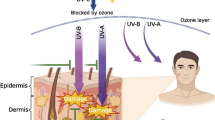Abstract
Exposure of the intact frog skin to β-adrenergic agonists stimulates chloride secretion by the exocrine glands. The secretory response is dependent on Na in the serosal bath and is inhibited by exposure to ouabain and furosemide. Thus the transport mechanism has properties similar to those described for other exocrine glands. Analysis of3H-ouabain binding sites and determination of intracellular ions by energy dispersive x-ray microanalysis indicates that the transepithelial pathway for Cl flux may be via a distinct group of cells located at the ductal pole of the acinus of two of the gland types; termed mucous and seromucous.
Similar content being viewed by others
References
Aceves J, Erlij D (1971) Sodium transport across the isolated epithelium of the frog skin. J Physiol 212:195–210
Benson BJ, Hadley ME (1969) In vitro characterization of adrenergic receptors controlling skin gland secretion in two Anurans:Rana pipiens andXenopus laevis. Comp Biochem Phys 30:857–864
Brown D (1980) Carbonic anhydrase localization in mounted cryostat sections. Stain Technol 55:115–118
Campbell JP, Aiyawar RM, Berry ER, Huf EG (1967) Electrolytes in frog skin secretions. Comp Biochem Phys 23:213–223
Dobyan DC, Bulger RE (1982) Renal carbonic anhydrase. Am J Physiol 243:F311-F324
Dockray GJ, Hopkins CR (1975) Caerulein secretion by dermal glands inXenopus laevis. J Cell Biol 64:724–733
Furuta YK, Hashimoto, Waslizaki M (1978) Beta adrenergic stimulation of exocrine secretion from the rat pancreas. Br J Pharmacol 62:25–29
Hoffman CW, Dent JN (1977) Effects of neurotransmitters upon the discharge of secretory product from the cutaneous glands of the red-spotted newt. J Exp Zool 202:155–162
House CR (1969) Secretory response to the stimulation of amphibian skin glands. Biochim Biophys Acta 173:344–347
House CR (1971) The effect of different ionic levels on the electrical response of toad skin to noradrenaline. J Physiol 218:305–324
Koefoed-Johnsen V, Ussing HH, Zerahn K (1952) The origin of the short-circuit current in the adrenaline stimulated frog skin. Acta Phys Scand 27:38–48
Lands AM, Arnold A, McAuliff JP, Luduena FP, Braun TG (1964) Differentiation of receptor systems activated by sympathomimetic amines. Nature 214:597–598
Lillywhite HB (1971) Thermal modulation of cutaneous mucous discharge as a determinant of evaporative water loss in the frog.Rana catesbeiana. Z Vergl Physiol 73:84–104
Lindley BD (1969) Nerve stimulation and electrical properties of frog skin. J Gen Physiol 53:427–449
McAfee RD (1970) The action of beta adrenergic site stimulating catecholamines on isolated frog skin. Biochim Biophys Acta 203:104–110
Mills JW, Prum BE (1984) Morphology of the exocrine glands of the frog skin. Am J Anat 171:91–106
Mills JW, Quinton PM (1981) Formation of stimulus-induced vacuoles in serous cells of tracheal submucosal glands. Am J Physiol 241 (Cell Physiol 10):C18-C24
Mills JW, Ernst SA, DiBona DR (1977) Localization of Na+-pump sites in frog skin. J Cell Biol 73:88–110
Mills JW, Rick R, Doerge A, Thurau K (1982) Intracellular electrolyte concentrations in the resting and isoproterenol stimulated exocrine glands of the frog skin. J Cell Biol 95:268a (abstr.)
Neuwirth M, Daly JW, Myers CW, Tice LW (1979) Morphology of the granular secretory glands in the skin of poison-dart frogs (Dendrobatidae). Tissue Cell 11:755–771
Noble GA, Noble ER (1944) On the histology of frog skin glands. Trans Am Microsc Soc 63:254–263
Pinschmidt MW, Campbell AD, Huf EG (1973) Role of Na+ and anions in the triple response of isolated frog skin to norepinephrine. Biochim Biophys Acta 323:309–325
Rosen S (1972) Localization of carbonic anhydrase activity in turtle and toad urinary bladder mucosa. J Histochem Cytochem 20:696–702
Rosen S, Friedley NJ (1973) Carbonic anhydrase activity in Rana pipiens skin: Biochemical and histochemical analysis. Histochem 36:1–4
Seldin JP, Hoshiko T (1966) Ionic requirement for epinephrine stimulation. J Exp Zool 163:111–114
Silva P, Stoff J, Field M, Fine L, Forrest JN, Epstein FH (1977) Mechanism of active chloride secretion by shark rectal gland: role of Na+−K+-ATPase in chloride transport 233 (Renal Fluid Electrolyte Phys 2):F298–F306
Skoglund CR, Sjoberg E (1977) In vitro studies of frog mucous glands. Acta Physiol Scand 100:457–470
Skoglund CR, Sjoberg E (1977) In vivo studies of individual mucous glands in the frog. Acta Physiol Scand 100:471–484
Skorofsky SM, Field M, Fozzard HA (1982) The cellular mechanism of active chloride secretion in vertebrate epithelia: Studies in intestine and trachea. Philos Trans R Soc Lond [Biol] 229:597–607
Thompson IG, Mills JW (1981) Isoproterenol-induced current changes in glands of frog skin. Am J Physiol 241 (Cell Physiol 10):C250-C257
Thompson IG, Mills JW (1983) Chloride transport in glands of frog skin. Am J Physiol 244:C221-C226
Tomlinson RS, Wood AW (1978) Effect of amiloride on catecholamine — induced changes in ion transport in short-circuited frog skin. J Membr Biol 40 (special issue):135–150
Watlington CO (1968) Effect of catecholamines and adrenergic blockade on sodium transport of isolated frog skin. Am J Physiol 214:1001–1007
Young JA, Van Lennup EW (1978) The morphology of salivary glands. Academic Press, New York, pp 26–27
Author information
Authors and Affiliations
Rights and permissions
About this article
Cite this article
Mills, J.W. Ion transport across the exocrine glands of the frog skin. Pflugers Arch. 405 (Suppl 1), S44–S49 (1985). https://doi.org/10.1007/BF00581779
Issue Date:
DOI: https://doi.org/10.1007/BF00581779




